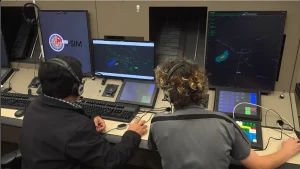The Growing Path to Air Traffic Control Careers Amid National Shortage
In the small city of Eastman, Georgia, a solution to America’s air traffic controller shortage is taking shape inside the classrooms and simulators of Middle Georgia State University. The nationwide deficit of controllers became painfully apparent during the recent federal government shutdown, when flight delays cascaded across the country due to thin staffing at critical facilities. According to FAA data analyzed by USAFacts, approximately 3,000 controller positions remain unfilled across the United States, with the agency aiming to hire at least 8,900 new controllers by 2028. This pressing need has breathed new life into a specialized college pathway designed to expedite controller training and get qualified candidates into towers faster.
The Enhanced Air Traffic Collegiate Training Initiative (AT-CTI) program represents a significant evolution in controller education. Unlike the traditional route requiring all new hires to complete extensive training at the FAA Academy in Oklahoma City, this program allows students at select universities to train to equivalent standards locally. “Enhanced CTI eliminates your requirement of going to the academy. You will graduate here and you can go straight to work,” explains Kemarie Jeffers, department chair of aviation science and management at Middle Georgia State. “It saves you time and effort — it gets you to work sooner and making money quicker.” While graduates still need to pass the Air Traffic Skills Assessment test, medical exams, security clearances, and facility-specific training, the program removes a significant bottleneck in the hiring pipeline by bypassing the academy’s long waitlists and multi-month courses.
Middle Georgia State’s air traffic control simulator offers a window into the demanding world these students are preparing to enter. Brooke Graffagnino, a student in the program, describes the intensity that initially attracted her to this career path: “It kind of gets your chest beating, because with how much traffic there is, sometimes it is intense.” She notes that the program quickly separates those truly suited for the pressure from those who aren’t. “You can kind of tell who does not [love it]. There have been quite a few, and they are no longer here. It takes a lot to get through it,” she reflects. The training continuously reinforces the critical nature of air traffic control, particularly in congested airspace. “Once you get in the airspace that is super crowded or approaching the larger airports like Atlanta, you need someone to help coordinate and keep everything separate and safe,” Graffagnino explains, highlighting the profound responsibility controllers shoulder.
The Enhanced AT-CTI designation doesn’t come easily. Only about nine schools nationwide have received this elevated status as of 2025, reflecting the rigorous standards institutions must meet. Middle Georgia State earned its approval in mid-2024 after substantial investments in equipment and curriculum. “We’ve upgraded a lot of our equipment… we had to install audio and video equipment upstairs in our tower sim,” Jeffers says, describing changes that allow FAA officials to remotely monitor training sessions to ensure they meet federal standards. The program must employ instructors with controller experience and maintain simulation equipment comparable to what’s used in actual facilities. The impact of this enhanced designation on enrollment has been dramatic—the program nearly tripled from about 20 students to 54 shortly after receiving approval.
As students progress through the program, they face increasingly complex scenarios designed to test their abilities under pressure. “As we get more comfortable and confident, we are able to allow more aircraft into the airspace at a time,” Graffagnino explains. The simulations gradually introduce more variables, higher traffic volumes, and more challenging conditions to prepare students for real-world situations. Before graduation, every student must pass a comprehensive final simulation that mirrors the evaluation process at the FAA Academy. “Our instructors will then run a scenario and they will be graded… the exact same way in which they will be graded at the academy,” Jeffers says. This rigorous evaluation ensures graduates are truly prepared for the demands of controlling live traffic at actual facilities.
The FAA’s workforce planning reveals the continuing challenge ahead, with the agency anticipating approximately 2,000 new controller hires in FY 2025, increasing to 2,200 in FY 2026, with further incremental growth through 2028. However, these gains will be partially offset by ongoing retirements among the aging controller workforce. Programs like Enhanced AT-CTI represent an innovative approach to addressing this critical staffing shortage, providing a more efficient pathway for qualified candidates while maintaining the rigorous standards essential for aviation safety. As Middle Georgia State and other approved institutions expand their programs, they offer a promising solution to one of aviation’s most pressing challenges—ensuring there are enough skilled professionals keeping watch over America’s increasingly busy skies.











